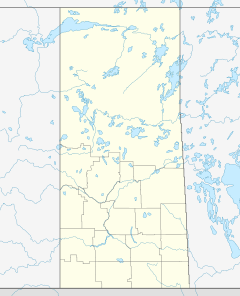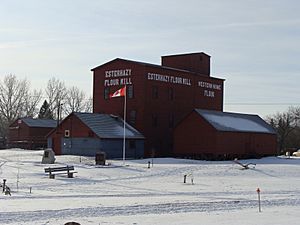Esterhazy Flour Mill facts for kids
| Location | Esterhazy, Saskatchewan |
|---|---|
| Management | Friends of the Flour Mill and the Town of Esterhazy |
| Coordinates | 50°39′11″N 102°4′16″W / 50.65306°N 102.07111°W |
| Construction | |
| Built | 1904 |
| Completed | 1907 |
| Decommissioned | Operations at the mill ceased in the 1980s. |
| Official name: Esterhazy Flour Mill National Historic Site | |
| Designated: | 2009 |
The Esterhazy Flour Mill is a very old building in Esterhazy, Saskatchewan. It is located at 517 Smith-Dorrien Street. Building the mill started in 1904 and finished in 1907. Today, the Town of Esterhazy owns it. A group called the Friends of the Flour Mill helps to manage it.
This mill is special because it's the only wood-frame flour mill left in Saskatchewan. It was named a Provincial Heritage Property in 2005. Then, on July 8, 2009, it became a National Historic Site. This means it's an important part of Canada's history.
Contents
History of the Esterhazy Flour Mill
James Saunders built the Esterhazy Flour Mill between 1904 and 1907. There were some delays because materials didn't arrive on time. But finally, the mill started grinding grain on June 18, 1907.
James Saunders was a small business owner from Whitewood, Saskatchewan. He mostly sold flour to people living near his mills. He only exported extra flour. Saunders owned mills in both Manitoba and Saskatchewan. This included the Whitewood Milling Company. The Esterhazy mill bought grain from local farmers. This helped the local economy. It also kept the railroad busy all year round.
The first manager of the mill was Mr. Snider. He left in September 1907. J.A. Macdonald took over for the winter. In 1908, W.S. Ford became the head miller and manager. In 1909, Saunders' other mill in Whitewood burned down. So, Frank Size, who was the miller there, leased the Esterhazy Flour Mill. In 1911, Frank Size bought the mill from James Saunders. He continued to be the head miller.
Rudolph Junek bought the mill in 1939. He ran it with his brother Stanley Junek and Charlie Lake. During the war years, they mostly made white flour. But they also made brown flour. Farmers could bring their own wheat to the mill. They could have it ground for their own use without special permits.
In 1947, Junek changed the mill's power source. It used to run on steam. He switched it to diesel power. A powerful UD18A International engine was installed. It could produce 125 horsepower.
The mill changed owners several times after Rudolph Junek passed away in 1949. His brother Joseph Junek bought it. He ran it with Stanley Junek and Charlie Lake. In 1959, Joseph sold the mill because he was not well. It was bought by John Jurick and Frank Pittner. Soon after, John Kacsmar bought Pittner's share. Kacsmar and Jurick ran the mill until 1962. Then Kacsmar bought out Jurick's share. Otto Roseler later took over running the mill. Kacsmar still helped when needed.
In 1977, the mill was sold to Kurt Zwolinski from Virden, Manitoba. But he had money problems. So, ownership went back to Roseler. Roseler ran the mill until 1979. Then he sold it to Martin Ritlop. Ritlop also faced financial issues. So, the mill went back to Roseler again. Roseler owned the mill when he passed away in June 1979. He left the mill to the Grey Sisters, who ran the Esterhazy Hospital. But the Grey Sisters did not take the mill. So, Ritlop was able to buy it back.
Martin Ritlop was the last person to own and operate the mill. He owned it from 1979 to 1994. The mill stopped making flour in 1980. It sat empty until 1994. That's when the Town of Esterhazy took ownership. They got it because of unpaid taxes.
How Much Flour It Made
The amount of flour the mill made changed each year. It also changed depending on the time of year. The Esterhazy Flour Mill was a medium-sized mill. It could process 15 bushels of wheat in one hour. That would make about 600 pounds of flour. The mill's work depended on having good wheat available. In the early years, repairs were done in the summer. Then, production started again in the fall when new crops were ready. The mill was quite busy in its early days. By April 1913, it had ground 40,000 bushels of wheat.
During the Depression, the mill's operations were not steady. Grain was brought in only when local grain was not good or not available.
How Flour Was Made
The Esterhazy Flour Mill used a special method to grind wheat. It was called the Hungarian-patented roller process. This method was used for the hard spring wheat grown on the prairies. When it was installed in 1907, this milling process was very modern and advanced.
The Mill Today
The Esterhazy Flour Mill is still the only wood-frame flour mill left in Saskatchewan. It's like a time capsule! It still has almost all of its original equipment. This shows how flour was made long ago.
Saving the Mill
After the mill stopped working, no one took care of it. The building started to fall apart. The roof leaked, damaging the floors. Windows broke, and pigeons made nests inside. When the Town of Esterhazy took over, they tried to find someone to restart the mill. But they couldn't. In 1995, they thought about studying how much it would cost to get it working again. But this idea was later dropped. Some people in Esterhazy wanted to tear the mill down because it looked so bad.
But in February 1996, the town decided not to demolish it. Two groups were interested in saving the mill. One was Hubert Lacoste, a miller from Quebec. The other was the Saskatchewan Heritage Branch. Someone suggested making organic flour, but that didn't happen. The Saskatchewan Heritage Branch pointed out that the Esterhazy Flour Mill was unique. It was the only one of its kind in Saskatchewan with all its original equipment. They also said there was money available to fix the outside of the building.
A group called "Friends of the Esterhazy Flour Mill" was formed. The town then officially named the mill a Municipal Heritage Property. The committee made a list of things to do. These included fixing the equipment, cleaning the mill, and collecting old documents about it. They also planned to renovate the outside. A group of volunteers started cleaning the mill in the summer of 1996. They learned how to restore old buildings from the provincial government. The restoration work used the right materials. It followed national rules for fixing up historic places.
Becoming a Provincial Historic Site
The Esterhazy Flour Mill got a special plaque on July 30, 2005. This plaque officially recognized it as a Provincial Heritage Property. The announcement had been made earlier in 2005. But the plaque was unveiled during Esterhazy's 100th birthday celebrations.
Becoming a National Historic Site
On July 8, 2009, the Esterhazy Flour Mill became a National Historic Site. It is one of 44 National Historic Sites in Saskatchewan. A plaque to celebrate this was unveiled on September 3, 2011. Mr. Garry Breiktreuz, a Member of Parliament, unveiled the plaque. He did this on behalf of the Environment Minister, who is in charge of Parks Canada.



